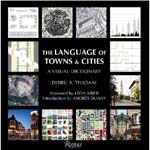
|

|
|
Home Site Search Contact Us Subscribe
|
|
|
Book Review: How New Urbanism's Case Triumphs Best Through "The Language of Towns & Cities: A Visual Dictionary" by Dhiru A. Thadani Thadani's oversized reference charms, infuriates, and enlightens. By Norman Weinstein January 14, 2011 New Urbanism has spawned a formidable literature in recent years, particularly in terms of carefully reasoned arguments regarding likely dire scenarios of urban chaos and suburban sprawl if oil dependency continues at its present mad rate. Unfortunately for some of us thoroughly convinced of the ecological case for cities designed sensibly along New Urbanism principles, the model communities of Seaside, Celebration, and Poundbury offer nerve-dulling aesthetic blandness, robbing our souls of messy urban beauty as surely as our current cities rob the natural resources needed to sustain future generations. So Dhiru A. Thadani’s The Language of Towns & Cities: A Visual Dictionary (Rizzoli, 2010) arrives at a propitious moment to work as a majestic tool to expand the horizons of New Urbanism so that it can shed its aesthetically dowdy image and get a long overdue facelift from avant-garde designers.
This said, Thadani would probably dislike my suggested use for his over-ambitious Pictionary. Lest you doubt his general fidelity to mainstream NU principles and aesthetic tastes, Leon Krier wrote the foreword and Andres Duany wrote the introduction. There’s the de rigueur Gehry and stararchitect bashing, with the usual photo of a Gehry building framed to look menacing. And a portrait of Prince Charles that makes him look...princely. Look past this expected party-line stuff. You discover that Thadani’s teachers have included Louis Kahn, Jane Jacobs, Michael Graves, and John Hejduk – all of whom might have found living in Seaside terminally quaint.
So while some of Thadani’s captions for his hundreds upon hundreds of photos, diagrams, and maps can border on the infuriatingly glib, his picture-show provokes far more questions than it answers. There’s a deeply moving inner struggle within the author, best exemplified by his entries on “Arcadia” and “Nostalgia” in which you can sense a wish, a longing for “City Beautiful” urban design (circa 1893) co-existing with 21st-century sustainable innovations in a digitally-networked metropolis. He reluctantly acknowledges the architectural flair of Paul Rudolph’s Temple Street Parking garage (in New Haven, Connecticut) on the one hand, while concluding his photo caption with its “deadening, overbearing impact should not be emulated.” Note also the admission in his entry on the “Bilbao Effect” that to some extent it has “worked.”
These complex contradictions are obviously ours, not merely Thadani’s. With the hi-tech to build urban architecture that looks like any imagining, we’re left with monumental aesthetic, ethical, economic, and environmental questions, and multi-layered contextual concerns pertaining to this giddy design freedom. Thadani’s conservatism in mining the past pragmatically is crucial, particularly in the current digital atmosphere of experimentation for the hell (hopefully heaven) of it, newness as supposed value-added by virtue of novelty. For all of his warmly affirming captions about picture-perfect Seaside and Celebration, his ultimate exemplar of New Urbanism design principles in action is untidy Paris, replete with its “bizarre” new architecture, as once the Eiffel Tower was widely labeled.
This invaluable book of pictorial wonders immerses you in actual and potential urban scenarios. It is vastly entertaining, endlessly provocative, and essential whatever one’s feelings about the utility of New Urbanism. No better visual dictionary pertaining to any facet of architecture and urbanism has ever been produced.
Norman Weinstein writes about architecture and design for Architectural Record, and is the author of “Words That Build” – an exclusive 21-part series published by ArchNewsNow.com – that focuses on the overlooked foundations of architecture: oral and written communication. He consults with architects and engineers interested in communicating more profitably; his webinars are available from ExecSense. He can be reached at nweinstein@q.com.
More by Weinstein:
A Meditation on the Beauty of Zaha Hadid's Door Handle Hadid's design issues a challenge: define beauty by lyrically playing with illusion.
Why "Greatest
Hits" Lists by Architecture's Stars Should Be Mocked
Celebratory Meditations on SANAA Winning the Pritzker Prize
Op-Ed: Life After Ada: Reassessing the Utility of
Architectural Criticism
Best Architecture
Books of 2010
Book
Review: "Architecture and Beauty: Conversations with Architects about a
Troubled Relationship": Yael Reisner exuberantly interviews architects
about beauty
Book Review: Shedding
Light on Concrete: Tadao Ando: Complete Works 1975-2010 by Philip Jodidio
Book Review: Sage
Architectural Reflections from Architecture's "Athena": Denise Scott
Brown's "Having Words" distills a lifetime of theorizing and practice
into practical and succinct guidance for thriving through difficult times
Book Review: Keeping
the Architectural Profession Professional: "Architecture from the Outside
In: Selected Essays by Robert Gutman" celebrates Gutman's legacy as
invaluable outsider
Book Review:
"Design through Dialogue: A Guide for Clients and Architects," by
Karen A. Franck and Teresa von Sommaruga Howard
Twilight Visions: Vintage Surrealist Photography Sheds
New Light on Architecture
Best
Architecture Books of 2009
Book Review: "Gunnar Birkerts: Metaphoric Modernist" by Sven Birkerts and Martin Schwartz A major architect in the history of Modernism finally receives recognition – and sundry asides about why Modernism never exited.
Book Review:
"Urban Design for an Urban Century: Placemaking for People," by Lance
Jay Brown, David Dixon, and Oliver Gillham
Book Review:
"Everything Must Move: 15 Years at Rice School of Architecture
1994-2009"
Book Review: A Subversive Book Every Architect Needs:
"Architect's Essentials of Negotiation" by Ava J. Abramowitz
Book Review: A Perspective from One Elevation: "Conversations With Frank Gehry" by Barbara Isenberg Gehry's conversations offer portraits of an astute listener as well as talker, an architect as aware of his flaws and limitations as of his virtues.
Best Architecture Books of 2008
Book Review: You've Got to Draw the Line Somewhere A review of Drafting Culture: a Social History of Architectural Graphic Standards by George Barnett Johnston
Book Review: "NeoHooDoo: Art for a Forgotten Faith," edited by Franklin Sirmans Sharpen your pencils - and get ready to do a NeoHooDoo shimmy.
|
(click on pictures to enlarge) 
|
© 2011 ArchNewsNow.com